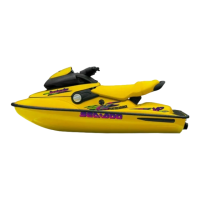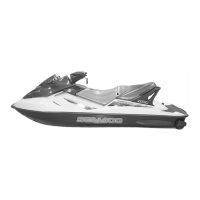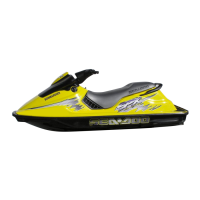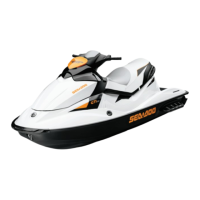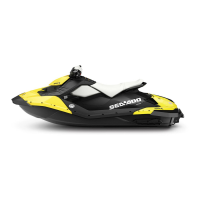71
TROUBLESHOOTING
The following chart is provided to help in diagnosing the probable source of simple
troubles. You may be able to solve many of these problems rather quickly, but
others may require the skills of a mechanical technician. In such cases, consult
an authorized SEA-DOO dealer for servicing.
Monitoring Beeper Coded Signals
CODED SIGNALS POSSIBLE CAUSE REMEDY
2 short beeps
(while installing safety
lanyard on post).
• Confirms safety lanyard signal
operation.
Engine can be started.
1 long beep
(while installing safety
lanyard on watercraft post or
when pressing engine
start/stop button).
• Safety lanyard on post for more
than 10 minutes without start-
ing engine.
Apply a slight pressure or remove
and reinstall safety lanyard on post.
• Bad connection.
Reinstall safety lanyard cap correct-
ly over post.
• Wrong safety lanyard.
Use a safety lanyard that has been
programmed for the watercraft.
• Defective safety lanyard.
Use another programmed safety
lanyard.
• Dried salt water in safety lanyard
cap.
Clean safety lanyard cap to remove
salt water.
• Improper operation of MPEM
or defective wiring harness.
Refer to an authorized SEA-DOO
dealer.
1 second beep every second
intervals.
• Engine drowned mode is active. Release throttle to cancel this
mode.
A 2 seconds beep every
2 seconds intervals.
• Exhaust system overheat.
See engine OVERHEATING.
A 2 seconds beep every
minute intervals.
• Fuel tank level is low.
Refill as soon as possible.
• Very low battery voltage.
Refer to an authorized SEA-DOO
dealer.
• Coolant and exhaust gas tem-
perature sensors or TPS
(throttle position sensor) or CPS
(crankshaft position sensor)
malfunction.
Refer to an authorized SEA-DOO
dealer.
• MPEM malfunction.
Refer to an authorized SEA-DOO
dealer.
A 2 seconds beep every
15 minutes intervals.
• Oil injection reservoir level is low.
Refill.
Continuously beeps.
• Engine overheats.
See engine OVERHEATING.
smo2003-005a.book Page 71 Friday, November 1, 2002 8:25 AM

